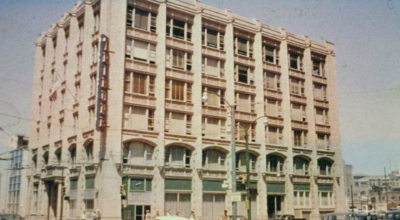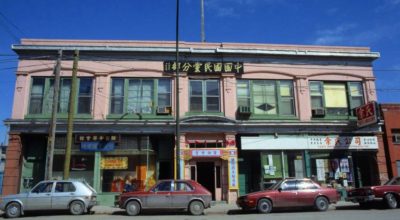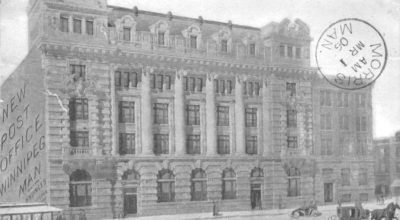
/ Blog
October 16, 2019
Fire Fuels Uncertainty: The Keewayden Building
Real estate was a hot commodity in Winnipeg at the turn of the 20th century. Companies new and old were coming through the city, looking to take advantage of a booming economy and quickly growing population. Larger, wealthier companies could get away with constructing their own office buildings while many others utilized the wealth of rental space available in Winnipeg.
The Notre Dame Investment Company capitalized on the need for space, and in 1909 invested in a modern 7-storey office building near Portage and Main. Construction of Keewayden Block cost $70,00 with James McDiarmid acting as both the architect and contractor. McDiarmid had been working in Winnipeg for well over two decades by this point, starting out as a contractor and moving into designing buildings by the early 1890s. McDiarmid worked on a number of notable projects in downtown Winnipeg, including the Pantages Playhouse Theatre and the Manitoba Legislature (after the original contractor, Thomas Kelly, had been fired from the project). McDiarmid would design a Chicago Style office building for the Notre Dame Investment Company.
Chicago Style buildings had become the preferred architectural style for modern office spaces in Winnipeg, and there are many excellent examples running along Portage Avenue – the then-commercial hub of Winnipeg.
Unsurprisingly, the origins of the Chicago School styles of architecture are tied back to Chicago architects in the 1880s and 90s. The main trappings of this style, which can be seen in the Keeywaden Building, are a brick or stone clad steel frame structure with little exterior ornamentation. Styled like a column, the Keeywaden Block has a ground floor with large windows reflective of a column’s base. The central part of the structure, the body of the column, consists of windows aligned in a grid pattern. The building’s upper floors, then, are the column capital – finished with a cornice and a flat roofline. In the case of the Keeywaden Block, the roofline boldly features the buildings name.
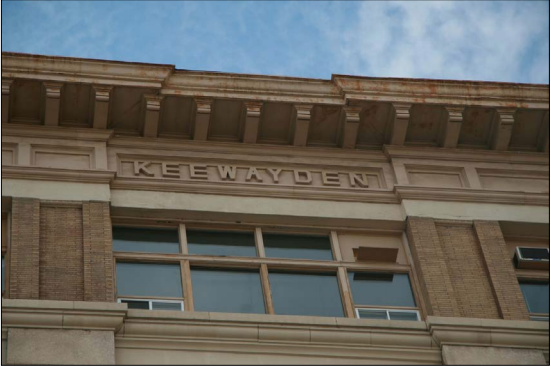
The Keewayden Building’s Roofline, complete with building name.
Source: Murray Peterson, City of Winnipeg
Often the top and bottom floors would receive the bulk of the ornamentation. The Keeywaden Block features less ornamentation than some of Winnipeg’s other commercial buildings, done in the same style, but nevertheless is an excellent example of office architecture in Winnipeg near the turn of the 20th century.
Under the Notre Dame Investment Company’s management, some of the earliest tenants in the building would include architects like Raymond Carey and C.W.U Chivers, Factor Cigar Company, slew of insurance agencies and the Consulate for Austria-Hungary. Others companies would come and go, as business trends would shift and adapt over the years.
Once World War One broke out in 1914, Canadians across the country leapt to the assistance of the war effort. In Winnipeg, the women of the Red Cross took over the upper floor of Keewayden building and turned it into a production facility. Raw materials were stored in the building, to be shipped off to manufacturing facilities. Following strict Red Cross standards, medical supplies such as bandages would be made then shipped back to the Keewayden Building where the goods would be packaged and shipped off the front lines.
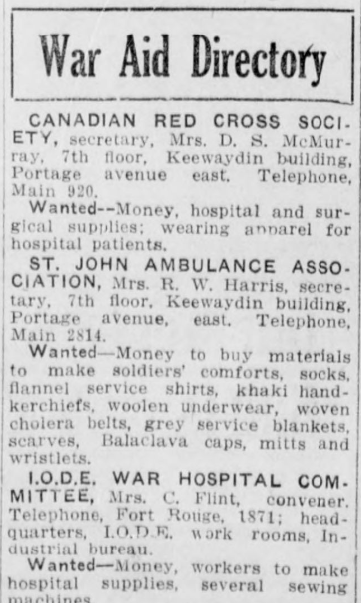
The Winnipeg Evening Tribune advertised places to drop off goods to help support the war effort.
Source: The Winnipeg Evening Tribune, 1915-07-26 (5)
After the war ended Winnipeg’s economy began to change. The warehouse industry Winnipeg had been built on was slowing down, and long-time Winnipeg companies were leaving Winnipeg’s downtown. This meant that large amounts of floor space was suddenly available, for a much lower cost than it had been a decade earlier. The 1920s, too, saw an increased demand for ready-made leisure wear for the working and middle class. Prior to this, Winnipeg’s garment manufacturers largely produced work clothes such as overalls – but consumer interest was changing, and garment companies sprung up in downtown Winnipeg as a result. By the late 1920s, two major clothing manufacturers were headquartered in the Keewayden Building: Reich Furs, and Jacob Crowley.
Founded by Elias Reich, Reich Furs had operated out of the sixth floor of Keewayden Block since at least 1926 – when a number of fur workers in Winnipeg walked off the job on strike on October 4th. Reich Furs kept around 60 scabs for the duration of this strike, leading to confrontations in front of the workspace later in the month. Tensions ran high and within the span of two days between October 25th-26th, there were multiple clashes between striking furriers and strike-breakers. The Keewayden Block was the set for one of these brawls on October 26th. Six strikers were arrested, four of them women, and between four or five strike breakers were injured. Some of those involved in the demonstration were attempting to enter and get to Reich’s Furs. It took well over a month for the strike to be called off, ending in early November.
Joining Reich sometime towards the end of the decade was Jacob Crowley. Benjamin Jacob and John H Crowley had worked together since 1914, and had founded Jacob Crowley in 1919 after buying out the business and equipment of Faultless Ladies’ Wear Limited. Jacob Crowley grew rapidly from four employees and a tiny space, to taking over two floors of the Keeywaden Block in the span of a decade.
Jacob Crowley became the major tenant of the building, to the point that the Keeywaden Block became known as the Jacob Crowley Building. They would remain in the space until 1988, and since then the building has been largely vacant.
Winnipeg today is no longer the warehouse hub of Western Canada, nor is it a hub of garment manufacturing. Our old warehouses are now full of tech companies, boutiques, galleries, and so much more – but redeveloping these spaces is not always easy work. The way we use our buildings are changing, and sometimes this means a building stays vacant while a new purpose and owner can be found. While successfully adapting empty heritage structures is a rewarding process, there are downsides to waiting for owners. Vacant heritage buildings are vulnerable, and without consistent care and maintenance, serious mechanical and cosmetic problems can arise!
Despite the building’s prolonged vacancy, the City of Winnipeg added the structure to their historic resources list in 2017.
Toronto based company No. 16 Hospitality began work on the Keewayden Building with plans to open a Hyatt Hotel in 2020 – plans that have, quite possibly, been delayed or abandoned since a fire broke out in the building on the weekend of September 30th. The circumstances of the fire are not yet known, but the roof and elevator shaft have been badly damaged by the blaze.
Redevelopment efforts were underway at the time of the fire: the interior had been gutted, and three rooms have been roughed out. Still, the future of the project is still up in the air and the financing of the Hyatt Hotel development has not been fully sorted.
This would not be the first time a redevelopment project in Winnipeg has stalled out due to lack of financing. The St Regis Hotel was slated for demolition, the interior gutted (including the historic Oak Room, now at Patent 5 Distillery on Pacific), and then the project fell through. Now the St. Regis hotel is still standing, abandoned and stripped, until a new developer can be found.
Hopefully the Keewayden Building’s redevelopment will go differently. The building’s future is not yet determined.
SOURCES:
A Stitch In Time
City of Winnipeg Report: 138 Portage Avenue
Biographical Dictionary of Architects in Canada
CBC News: Fire Engulfs Roof of Historic Building
CBC News: ‘I would have been surprised if it didn’t burn,’ says business owner next to charred heritage block
CBC News: Lawyer suspended for allegedly giving investors inflated values for fire-damaged Winnipeg hotel project
Winnipeg Tribune
THANK YOU TO THE SPONSOR OF THIS BLOG POST:

Written by Sabrina Janke on behalf of Heritage Winnipeg.






